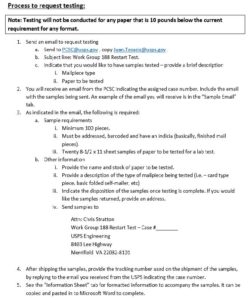June 23, 2022
Issue 22/07
The leading voice for nonprofits on postal issues for over 40 years.
© 2022 Alliance of Nonprofit Mailers—All rights reserved.
A 501 (c)(4) nonprofit organization established by nonprofits for nonprofits.
USPS ignores regulator again; favors packages again
In a recurring theme, the Postal Service announced changes to the service goals for certain packages, mostly ignoring an 87-page advisory opinion by the Postal Regulatory Commission. Effective August 1, Retail Ground and Parcel Select Ground packages will have their service standards sped up “from two- to eight-days to two- to five-days for the same affordable price.”
In addition to ignoring the work of the regulator, postal operators also reaffirmed their strategy to favor package delivery over mail. They are speeding up packages after slowing down mail. And USPS is not requiring higher prices for better package service.
The PRC raised several concerns in its June 9 advisory opinion:
- First, the Commission finds that there are immediate benefits from reducing the number of times RG and PSG pieces are handled during processing. However, the Commission is concerned that this proposal may result in an increased need for manual processing and staff availability for facilities already failing to meet operating plans. This could lead to disruptions in processing and transportation operations and cost increases.
- Second, the Commission finds that the projected transportation efficiencies reduced reliance on air transportation and a more efficient surface transportation network—are not evident in the near term. The Postal Service expects them to materialize over time, provided the proposed changes capture some of the demand for shipping of medium-speed, low-price, large packages via ground transportation. The Postal Service is unable to predict when these efficiencies might materialize. The Commission notes that the calculated transportation cost changes are based on numerous assumptions, several of which might be unrealistic.
- Third, the Commission finds that the planned changes have the potential for meeting market demand and enhancing service to customers sending larger packages. However, the Commission identifies several areas of concern relating to the market research conducted by the Postal Service and used to support its assertions. Specifically, the Commission notes the lack of research targeted to current customers of the products at issue.
The regulator then made five recommendations to USPS:
- Design a timeline, which includes all intended incremental changes to
the processing network operations and how each would contribute to
the eventual, more efficient, shape-based processing network
envisioned in its 10-year plan
- Design a plan to monitor all implications of each such incremental
network change, in order to learn from previous changes and fine-tune
subsequent changes
- Conduct more robust research into the market segment that the
upgraded RG and PSG service standards would attract, to gain a
better idea of this unknown profile in order to ensure that continued
provision of low prices for potentially high-cost shipping of new
volumes does not negatively impact contribution for RG and PSG
products
- Design and implement a plan to monitor the impact on shipping
options in the competitive parcels market, especially the impact
on mailers who actually use RG and PSG, mailers who are
particularly price-sensitive, and large-sized business mailers
- Design and implement a plan to monitor any volume diversion
from Priority Mail and the impact on other Postal Service
products.
The PRC press release summarized how powerless its advisory opinion is:
The Commission’s opinion is non-binding and advisory in nature. As a result, the Postal Service is not required to implement or take any further action with regard to the Commission’s advisory opinion. The Commission, however, encourages the Postal Service to review these recommendations with serious consideration.
The PRC explained in its opinion that decisions about USPS competitive package products “are left to the reasonable business judgment of the Governors of the Postal Service.” Further, the regulator stated that “market competition is expected to serve
as the primary guarantor of discipline with respect to price and service quality.”
The future of mail seems to depend on agency competition with excellent private sector shipping companies
Time will tell whether the future viability of our national postal system, which is now dependent on market success against private competitors such as Amazon, FedEx, and UPS, will succeed based on the business judgment of nine part-time appointees. This is not the first time the Governors have moved forward with the implementation of service changes shortly after the regulator raised serious concerns and opposition to the strategies. To a large extent, the Governors, who normally do not have analytic resources or dedicated staff, are placing their faith in the Postmaster General and his staff.
USPS restructures operations to help build a better logistics network
Postmaster General DeJoy promises to do what several predecessors were unable to do: to remake the USPS delivery network to be efficient, the right size, and compatible with less mail and more packages. He announced a major change to the top of USPS operations when he promoted Kelly Abney to the new position of Chief Logistics Officer and Executive Vice President. Logistics were deleted from Isaac Cronkite’s title and Vice President of Logistics Robert Citron was moved under Mr. Abney.
Mr. Abney’s logistics position was described as “leading the strategic design of a world-class transportation network and developing cost- and service-enhancing processes to enable optimization and execution through our plants and delivery operations. This new organization will lead the redesign of the surface transportation network, reduce air transport, improve carrier management, and deploy a state-of-art logistics platform.” According to USPS Abney “has over 30 years of Logistics, Transportation and Procurement experience. He previously held senior supply chains positions at Walmart, Sears/Kmart, Payless Cashways and XPO Logistics.”
It is a bit concerning that, two years into his tenure, Mr. DeJoy is just now putting a team in place to get costs under control. It also bears watching whether logistics expertise is what has been lacking. Previous PMGs had well-thought-out plans but were thwarted by political and union opposition. Perhaps a new set of eyes will yield results.
Kelly Abney
USPS responds to industry pressure for paper flexibility
On June 17, USPS announced a new process to apply for an exception to mail new types of paper. This is in response to major shortages of paper affecting many mailers. The Alliance confirmed that this is available to nonprofit mailers as well as the commercial mailers mentioned in the announcement.
The Postal Service posted instructions on how to request testing of new paper on PostalPro.
“2.4 Days: Average Time to Deliver Mail and Packages Across Nation”
Members have been asking about the repeated claims by USPS in press releases that the average time to deliver mail and packages is 2.4 days. Nonprofit mailers are not experiencing that kind of service with either their professional or personal mail. While it makes a good headline, it is important to recognize the limitations of the 2.4 days claim:
- Averages have limited value when individual pieces of mail mean a lot. Many prices of mail take much longer than 2.4 days; it’s just the nature of an average that reduces a large set of observations to one number.
- The PRC now allows USPS to measure its service with barcode scans. The original External First-Class (EXFC) measurement was done by external contractors (Price Waterhouse and IBM) that independently entered mail into the system and employed many individuals to report when they received the mail.
- USPS limits which types of mail are subject to measurement. There is a heavy emphasis on “Full Service” bulk mailings that meet stringent standards set by the agency. These mailings are very efficient to handle and often are entered close to the destination in the postal system. Smaller mailings and single-piece stamped mail are excluded from service measurement. These factors bias the average to a lower number.
- The final scan at a post office is considered the delivery date of the mail piece or package, even though it doesn’t always get delivered that day. This has been especially true during recent periods of staffing shortages.
- Postal managers and supervisors know which types of mail are subject to measurement, and their performance evaluations, and therefore have an incentive to give them a priority.
We advise nonprofit mailers to focus on their measurement of their mail and believe their numbers over headline claims by USPS. And remember the quote attributed to Benjamin Disraeli, “There are three types of lies — lies, damn lies, and statistics.” Or even better to Mark Twain: “Facts are stubborn things, but statistics are pliable.”




Leave a Reply